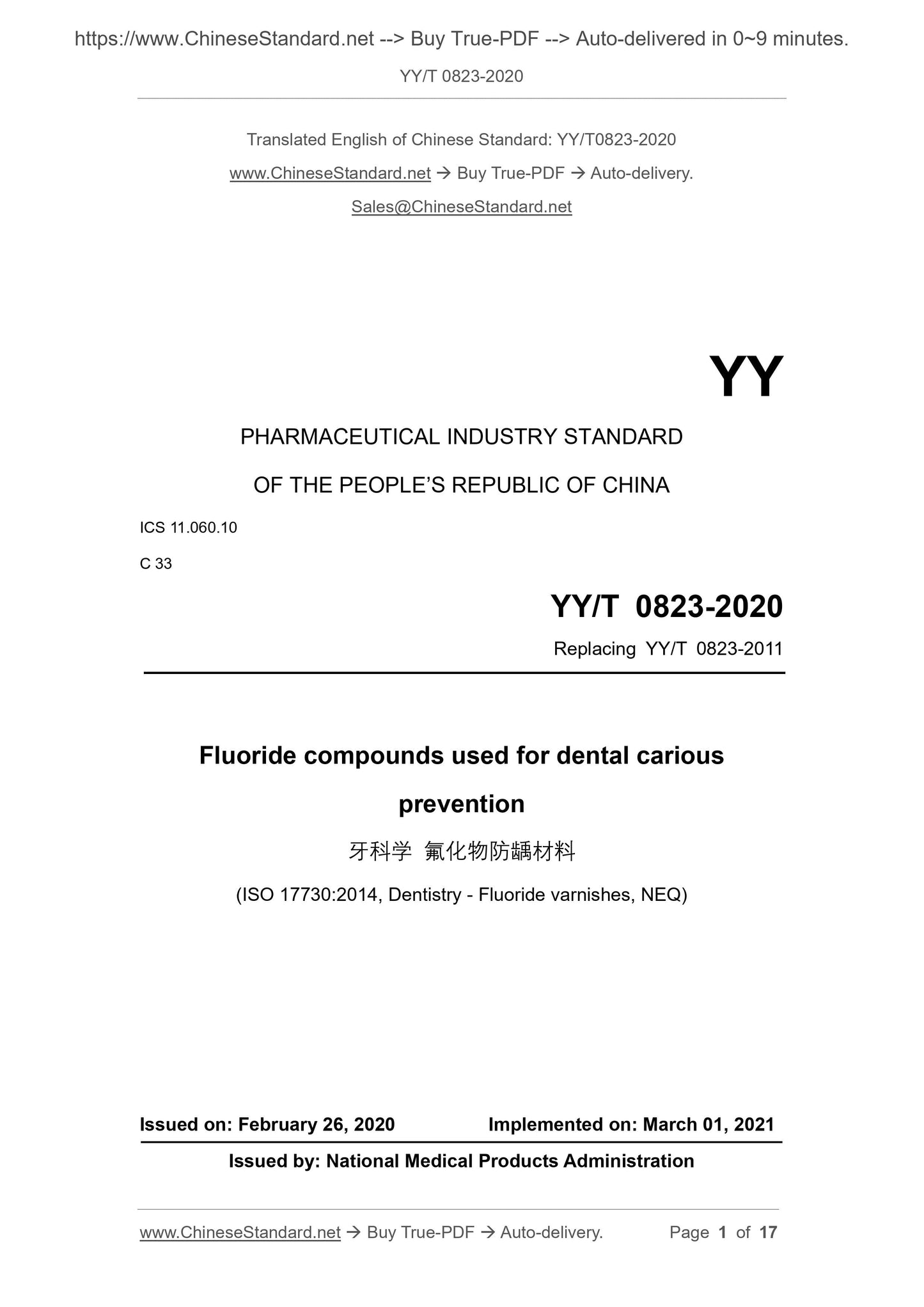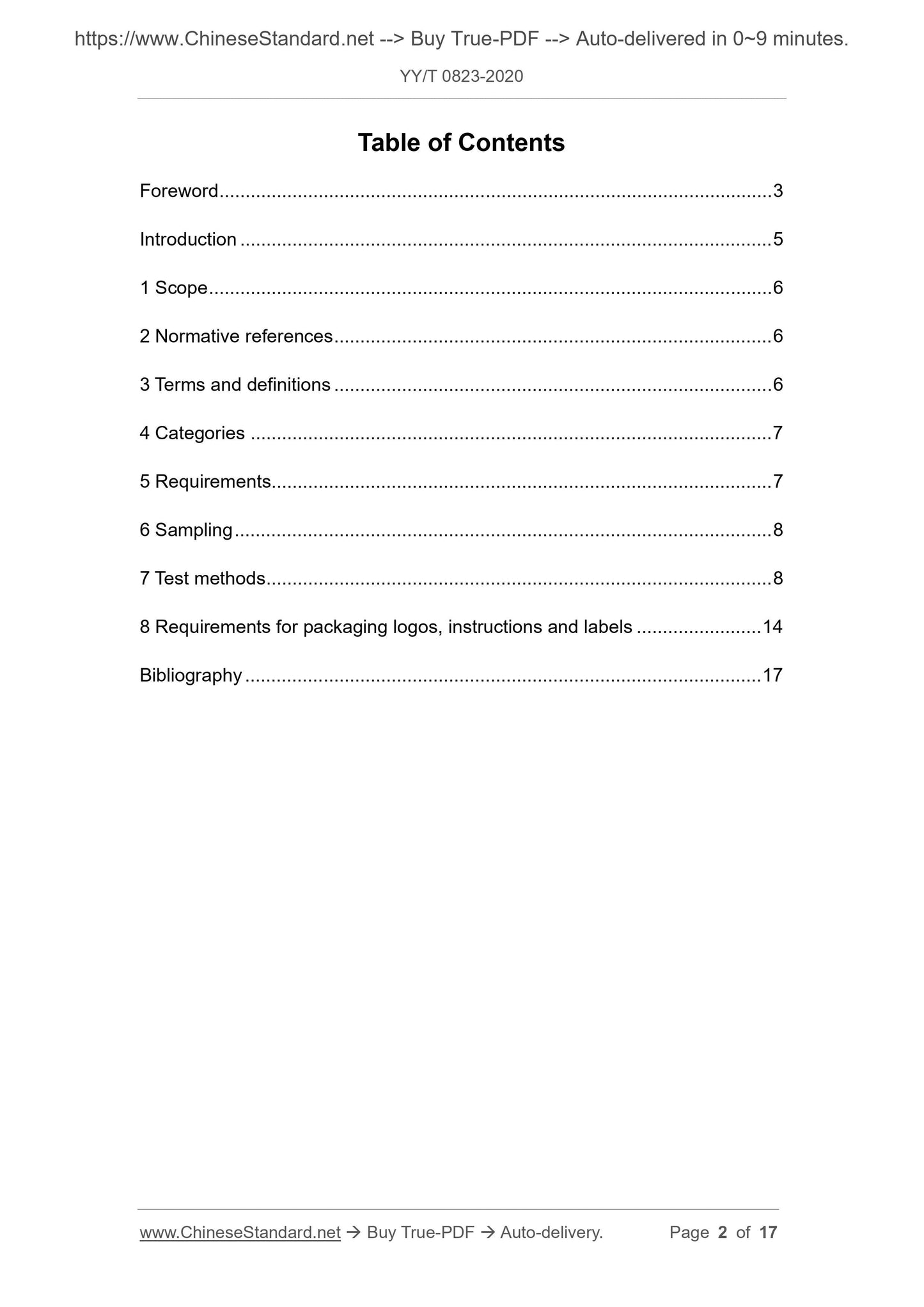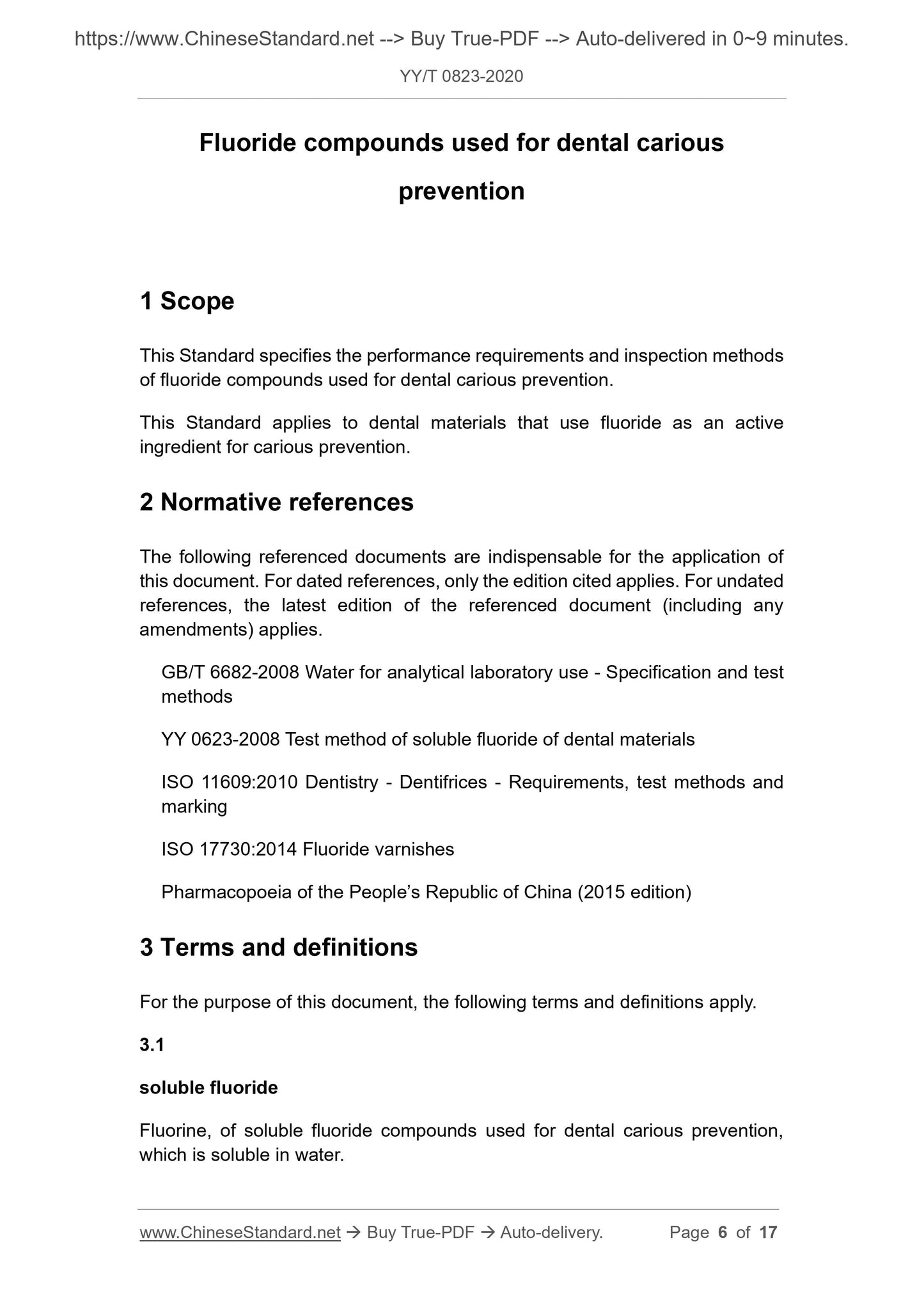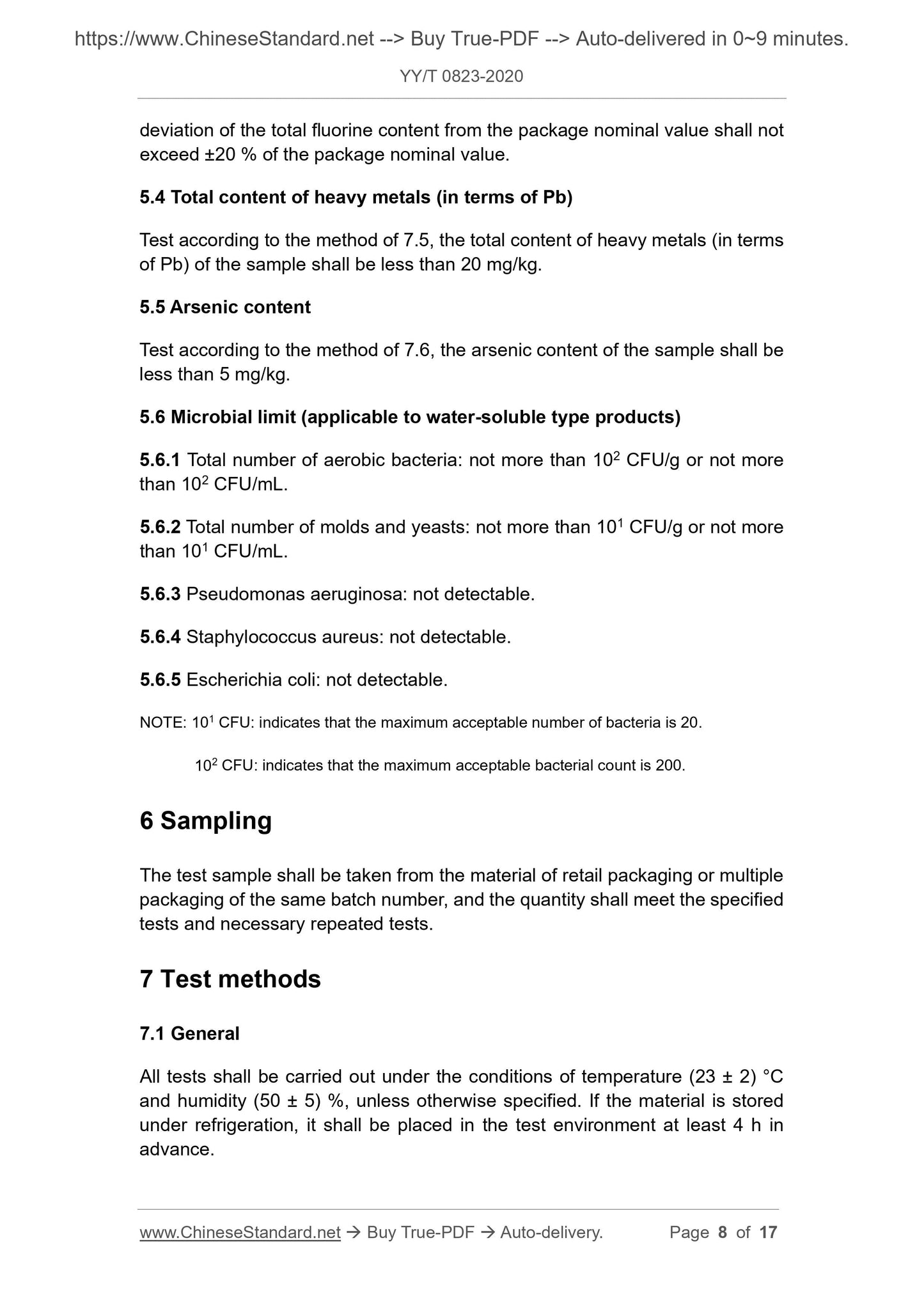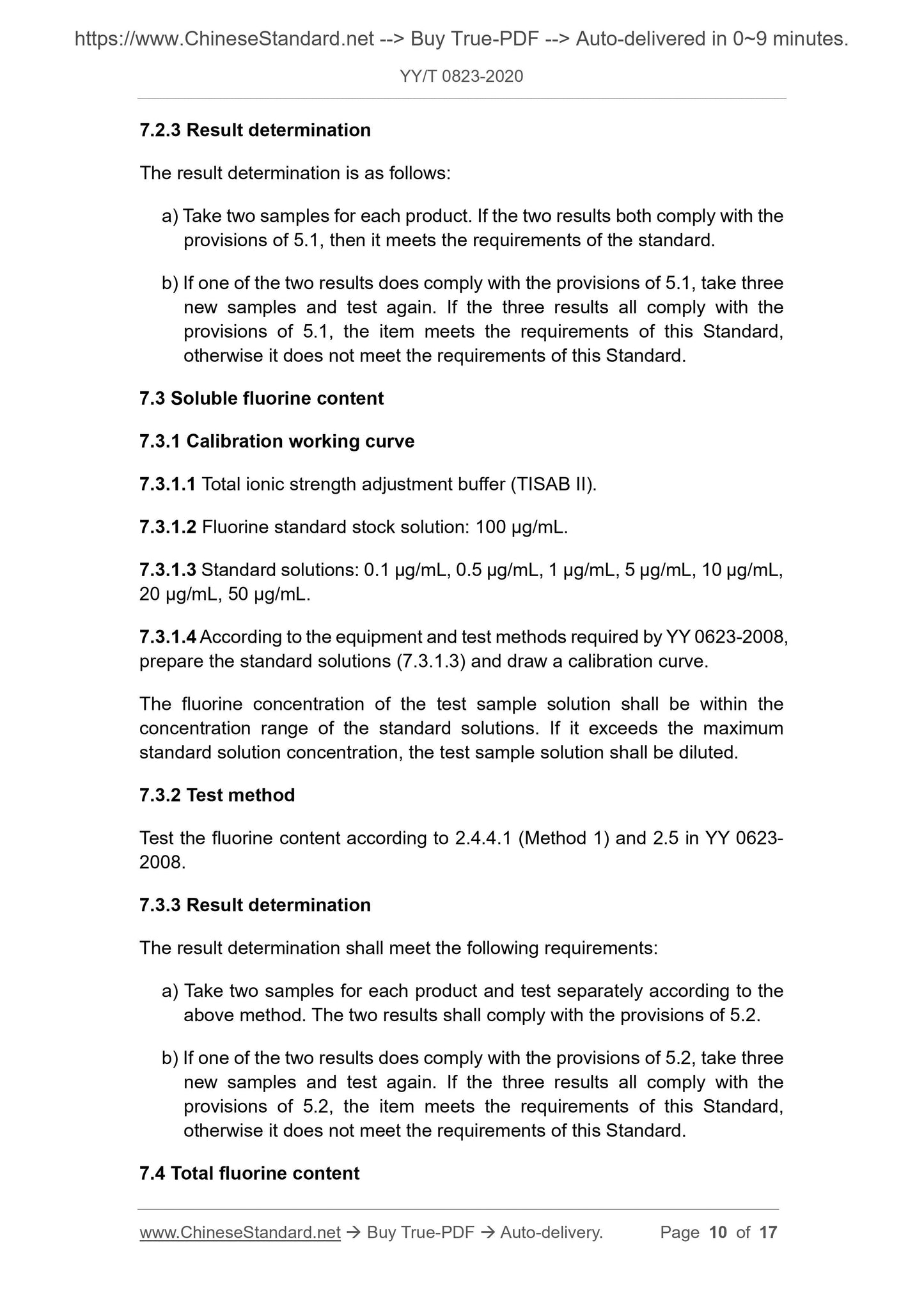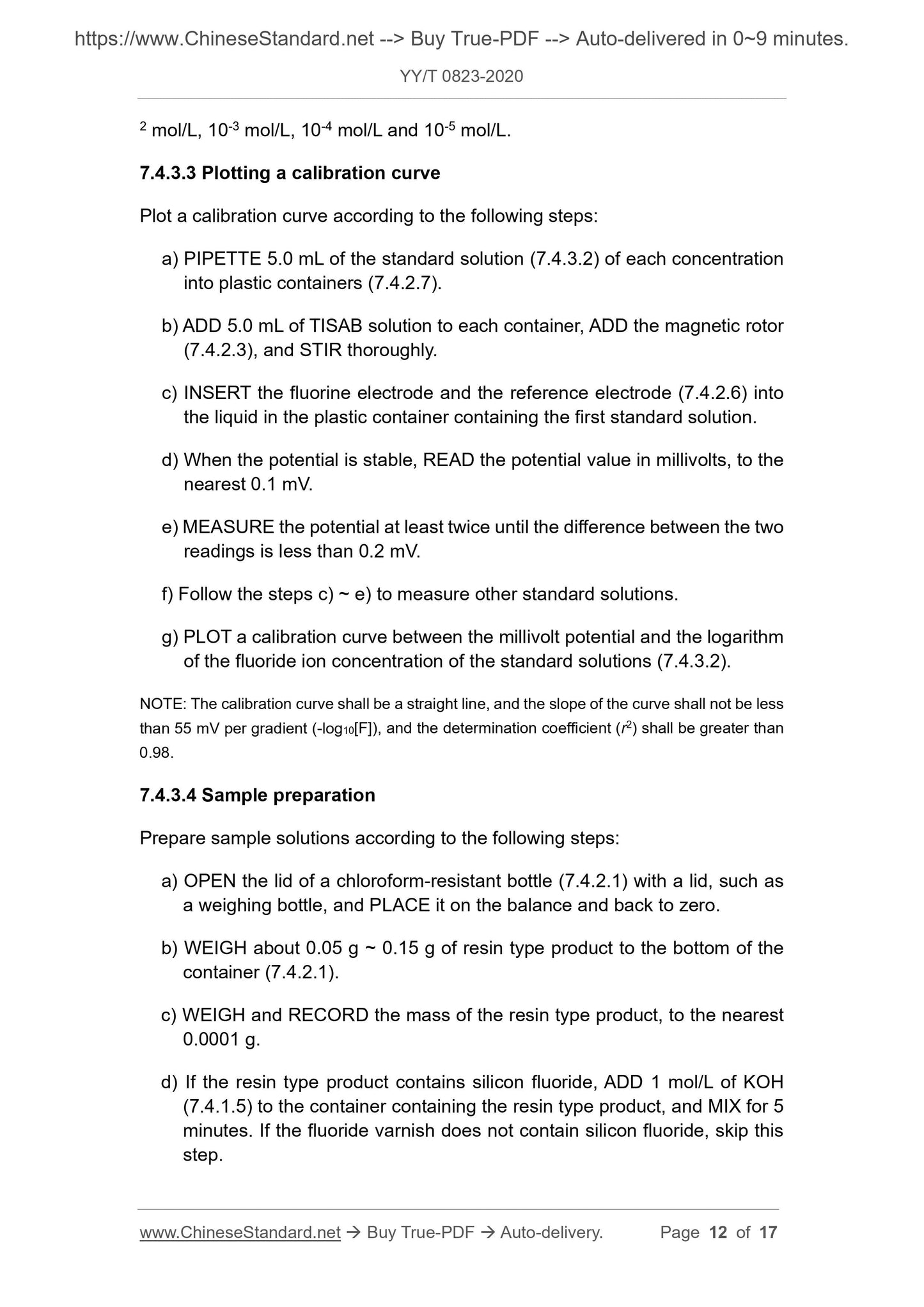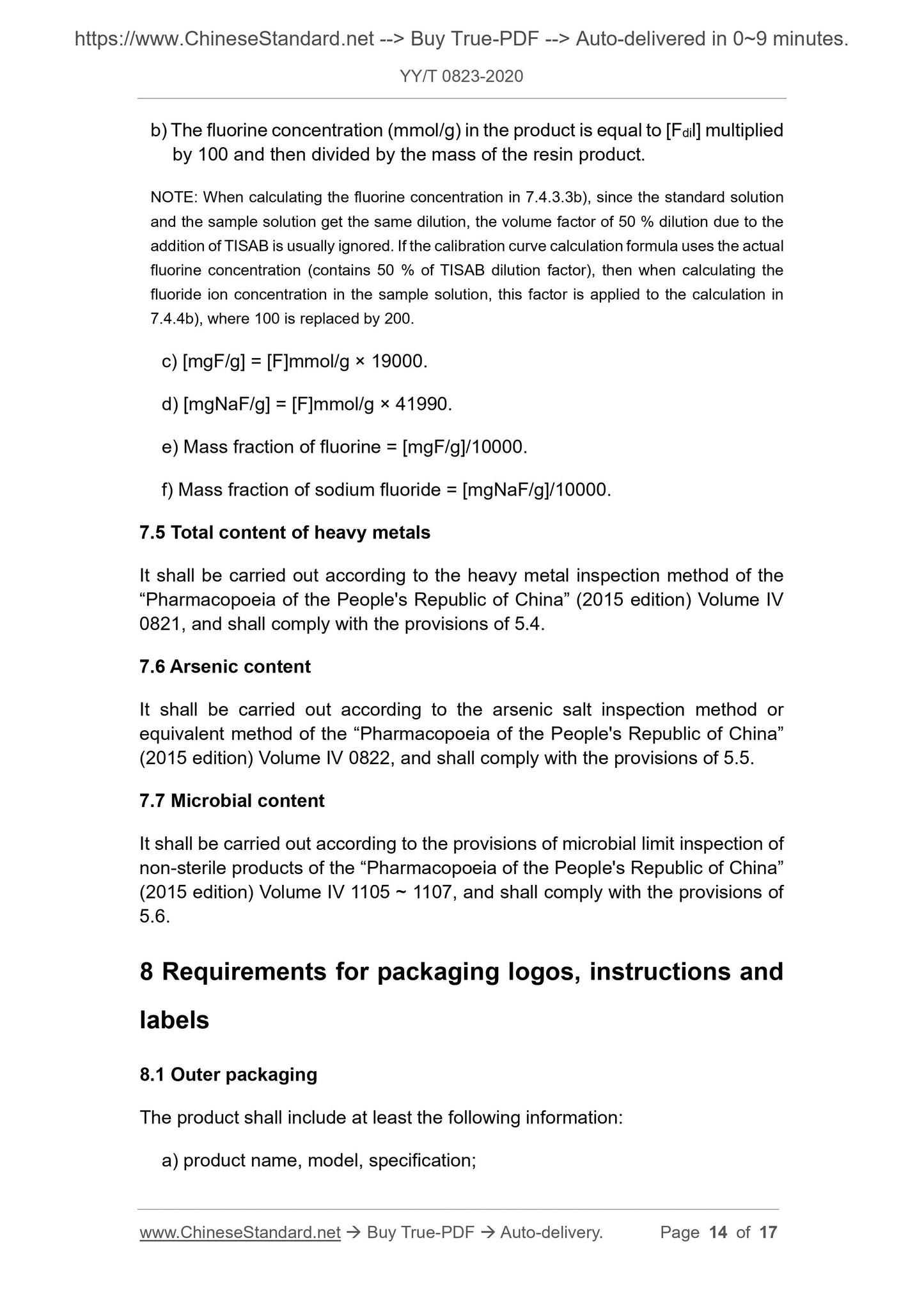1
/
su
7
PayPal, credit cards. Download editable-PDF & invoice in 1 second!
YY/T 0823-2020 English PDF (YYT0823-2020)
YY/T 0823-2020 English PDF (YYT0823-2020)
Prezzo di listino
$185.00 USD
Prezzo di listino
Prezzo scontato
$185.00 USD
Prezzo unitario
/
per
Spese di spedizione calcolate al check-out.
Impossibile caricare la disponibilità di ritiro
Delivery: 3 seconds. Download true-PDF + Invoice.
Get QUOTATION in 1-minute: Click YY/T 0823-2020
Historical versions: YY/T 0823-2020
Preview True-PDF (Reload/Scroll if blank)
YY/T 0823-2020: Fluoride compounds used for dental carious prevention
YY/T 0823-2020
YY
PHARMACEUTICAL INDUSTRY STANDARD
OF THE PEOPLE’S REPUBLIC OF CHINA
ICS 11.060.10
C 33
Replacing YY/T 0823-2011
Fluoride compounds used for dental carious
prevention
牙科学 氟化物防龋材料
(ISO 17730:2014, Dentistry - Fluoride varnishes, NEQ)
ISSUED ON: FEBRUARY 26, 2020
IMPLEMENTED ON: MARCH 01, 2021
Issued by: National Medical Products Administration
Table of Contents
Foreword ... 3
Introduction ... 5
1 Scope ... 6
2 Normative references ... 6
3 Terms and definitions ... 6
4 Categories ... 7
5 Requirements... 7
6 Sampling ... 8
7 Test methods ... 8
8 Requirements for packaging logos, instructions and labels ... 14
Bibliography ... 17
Fluoride compounds used for dental carious
prevention
1 Scope
This Standard specifies the performance requirements and inspection methods
of fluoride compounds used for dental carious prevention.
This Standard applies to dental materials that use fluoride as an active
ingredient for carious prevention.
2 Normative references
The following referenced documents are indispensable for the application of
this document. For dated references, only the edition cited applies. For undated
references, the latest edition of the referenced document (including any
amendments) applies.
GB/T 6682-2008 Water for analytical laboratory use - Specification and test
methods
YY 0623-2008 Test method of soluble fluoride of dental materials
ISO 11609:2010 Dentistry - Dentifrices - Requirements, test methods and
marking
ISO 17730:2014 Fluoride varnishes
Pharmacopoeia of the People’s Republic of China (2015 edition)
3 Terms and definitions
For the purpose of this document, the following terms and definitions apply.
3.1
soluble fluoride
Fluorine, of soluble fluoride compounds used for dental carious prevention,
which is soluble in water.
deviation of the total fluorine content from the package nominal value shall not
exceed ±20 % of the package nominal value.
5.4 Total content of heavy metals (in terms of Pb)
Test according to the method of 7.5, the total content of heavy metals (in terms
of Pb) of the sample shall be less than 20 mg/kg.
5.5 Arsenic content
Test according to the method of 7.6, the arsenic content of the sample shall be
less than 5 mg/kg.
5.6 Microbial limit (applicable to water-soluble type products)
5.6.1 Total number of aerobic bacteria: not more than 102 CFU/g or not more
than 102 CFU/mL.
5.6.2 Total number of molds and yeasts: not more than 101 CFU/g or not more
than 101 CFU/mL.
5.6.3 Pseudomonas aeruginosa: not detectable.
5.6.4 Staphylococcus aureus: not detectable.
5.6.5 Escherichia coli: not detectable.
NOTE: 101 CFU: indicates that the maximum acceptable number of bacteria is 20.
102 CFU: indicates that the maximum acceptable bacterial count is 200.
6 Sampling
The test sample shall be taken from the material of retail packaging or multiple
packaging of the same batch number, and the quantity shall meet the specified
tests and necessary repeated tests.
7 Test methods
7.1 General
All tests shall be carried out under the conditions of temperature (23 ± 2) °C
and humidity (50 ± 5) %, unless otherwise specified. If the material is stored
under refrigeration, it shall be placed in the test environment at least 4 h in
advance.
7.2.3 Result determination
The result determination is as follows:
a) Take two samples for each product. If the two results both comply with the
provisions of 5.1, then it meets the requirements of the standard.
b) If one of the two results does comply with the provisions of 5.1, take three
new samples and test again. If the three results all comply with the
provisions of 5.1, the item meets the requirements of this Standard,
otherwise it does not meet the requirements of this Standard.
7.3 Soluble fluorine content
7.3.1 Calibration working curve
7.3.1.1 Total ionic strength adjustment buffer (TISAB II).
7.3.1.2 Fluorine standard stock solution: 100 μg/mL.
7.3.1.3 Standard solutions: 0.1 μg/mL, 0.5 μg/mL, 1 μg/mL, 5 μg/mL, 10 μg/mL,
20 μg/mL, 50 μg/mL.
7.3.1.4 According to the equipment and test methods required by YY 0623-2008,
prepare the standard solutions (7.3.1.3) and draw a calibration curve.
The fluorine concentration of the test sample solution shall be within the
concentration range of the standard solutions. If it exceeds the maximum
standard solution concentration, the test sample solution shall be diluted.
7.3.2 Test method
Test the fluorine content according to 2.4.4.1 (Method 1) and 2.5 in YY 0623-
2008.
7.3.3 Result determination
The result determination shall meet the following requirements:
a) Take two samples for each product and test separately according to the
above method. The two results shall comply with the provisions of 5.2.
b) If one of the two results does comply with the provisions of 5.2, take three
new samples and test again. If the three results all comply with the
provisions of 5.2, the item meets the requirements of this Standard,
otherwise it does not meet the requirements of this Standard.
7.4 Total fluorine content
2 mol/L, 10-3 mol/L, 10-4 mol/L and 10-5 mol/L.
7.4.3.3 Plotting a calibration curve
Plot a calibration curve according to the following steps:
a) PIPETTE 5.0 mL of the standard solution (7.4.3.2) of each concentration
into plastic containers (7.4.2.7).
b) ADD 5.0 mL of TISAB solution to each container, ADD the magnetic rotor
(7.4.2.3), and STIR thoroughly.
c) INSERT the fluorine electrode and the reference electrode (7.4.2.6) into
the liquid in the plastic container containing the first standard solution.
d) When the potential is stable, READ the potential value in millivolts, to the
nearest 0.1 mV.
e) MEASURE the potential at least twice until the difference between the two
readings is less than 0.2 mV.
f) Follow the steps c) ~ e) to measure other standard solutions.
g) PLOT a calibration curve between the millivolt potential and the logarithm
of the fluoride ion concentration of the standard solutions (7.4.3.2).
NOTE: The calibration curve shall be a straight line, and the slope of the curve shall not be less
than 55 mV per gradient (-log10[F]), and the determination coefficient (r2) shall be greater than
0.98.
7.4.3.4 Sample preparation
Prepare sample solutions according to the following steps:
a) OPEN the lid of a chloroform-resistant bottle (7.4.2.1) with a lid, such as
a weighing bottle, and PLACE it on the balance and back to zero.
b) WEIGH about 0.05 g ~ 0.15 g of resin type product to the bottom of the
container (7.4.2.1).
c) WEIGH and RECORD the mass of the resin type product, to the nearest
0.0001 g.
d) If the resin type product contains silicon fluoride, ADD 1 mol/L of KOH
(7.4.1.5) to the container containing the resin type product, and MIX for 5
minutes. If the fluoride varnish does not contain silicon fluoride, skip this
step.
b) The fluorine concentration (mmol/g) in the product is equal to [Fdil] multiplied
by 100 and then divided by the mass of the resin product.
NOTE: When calculating the fluorine concentration in 7.4.3.3b), since the standard solution
and the sample solution get the same dilution, the volume factor of 50 % dilution due to the
addition of TISAB is usually ignored. If the calibration curve calculation formula uses the actual
fluorine concentration (contains 50 % of TISAB dilution factor), then when ...
Get QUOTATION in 1-minute: Click YY/T 0823-2020
Historical versions: YY/T 0823-2020
Preview True-PDF (Reload/Scroll if blank)
YY/T 0823-2020: Fluoride compounds used for dental carious prevention
YY/T 0823-2020
YY
PHARMACEUTICAL INDUSTRY STANDARD
OF THE PEOPLE’S REPUBLIC OF CHINA
ICS 11.060.10
C 33
Replacing YY/T 0823-2011
Fluoride compounds used for dental carious
prevention
牙科学 氟化物防龋材料
(ISO 17730:2014, Dentistry - Fluoride varnishes, NEQ)
ISSUED ON: FEBRUARY 26, 2020
IMPLEMENTED ON: MARCH 01, 2021
Issued by: National Medical Products Administration
Table of Contents
Foreword ... 3
Introduction ... 5
1 Scope ... 6
2 Normative references ... 6
3 Terms and definitions ... 6
4 Categories ... 7
5 Requirements... 7
6 Sampling ... 8
7 Test methods ... 8
8 Requirements for packaging logos, instructions and labels ... 14
Bibliography ... 17
Fluoride compounds used for dental carious
prevention
1 Scope
This Standard specifies the performance requirements and inspection methods
of fluoride compounds used for dental carious prevention.
This Standard applies to dental materials that use fluoride as an active
ingredient for carious prevention.
2 Normative references
The following referenced documents are indispensable for the application of
this document. For dated references, only the edition cited applies. For undated
references, the latest edition of the referenced document (including any
amendments) applies.
GB/T 6682-2008 Water for analytical laboratory use - Specification and test
methods
YY 0623-2008 Test method of soluble fluoride of dental materials
ISO 11609:2010 Dentistry - Dentifrices - Requirements, test methods and
marking
ISO 17730:2014 Fluoride varnishes
Pharmacopoeia of the People’s Republic of China (2015 edition)
3 Terms and definitions
For the purpose of this document, the following terms and definitions apply.
3.1
soluble fluoride
Fluorine, of soluble fluoride compounds used for dental carious prevention,
which is soluble in water.
deviation of the total fluorine content from the package nominal value shall not
exceed ±20 % of the package nominal value.
5.4 Total content of heavy metals (in terms of Pb)
Test according to the method of 7.5, the total content of heavy metals (in terms
of Pb) of the sample shall be less than 20 mg/kg.
5.5 Arsenic content
Test according to the method of 7.6, the arsenic content of the sample shall be
less than 5 mg/kg.
5.6 Microbial limit (applicable to water-soluble type products)
5.6.1 Total number of aerobic bacteria: not more than 102 CFU/g or not more
than 102 CFU/mL.
5.6.2 Total number of molds and yeasts: not more than 101 CFU/g or not more
than 101 CFU/mL.
5.6.3 Pseudomonas aeruginosa: not detectable.
5.6.4 Staphylococcus aureus: not detectable.
5.6.5 Escherichia coli: not detectable.
NOTE: 101 CFU: indicates that the maximum acceptable number of bacteria is 20.
102 CFU: indicates that the maximum acceptable bacterial count is 200.
6 Sampling
The test sample shall be taken from the material of retail packaging or multiple
packaging of the same batch number, and the quantity shall meet the specified
tests and necessary repeated tests.
7 Test methods
7.1 General
All tests shall be carried out under the conditions of temperature (23 ± 2) °C
and humidity (50 ± 5) %, unless otherwise specified. If the material is stored
under refrigeration, it shall be placed in the test environment at least 4 h in
advance.
7.2.3 Result determination
The result determination is as follows:
a) Take two samples for each product. If the two results both comply with the
provisions of 5.1, then it meets the requirements of the standard.
b) If one of the two results does comply with the provisions of 5.1, take three
new samples and test again. If the three results all comply with the
provisions of 5.1, the item meets the requirements of this Standard,
otherwise it does not meet the requirements of this Standard.
7.3 Soluble fluorine content
7.3.1 Calibration working curve
7.3.1.1 Total ionic strength adjustment buffer (TISAB II).
7.3.1.2 Fluorine standard stock solution: 100 μg/mL.
7.3.1.3 Standard solutions: 0.1 μg/mL, 0.5 μg/mL, 1 μg/mL, 5 μg/mL, 10 μg/mL,
20 μg/mL, 50 μg/mL.
7.3.1.4 According to the equipment and test methods required by YY 0623-2008,
prepare the standard solutions (7.3.1.3) and draw a calibration curve.
The fluorine concentration of the test sample solution shall be within the
concentration range of the standard solutions. If it exceeds the maximum
standard solution concentration, the test sample solution shall be diluted.
7.3.2 Test method
Test the fluorine content according to 2.4.4.1 (Method 1) and 2.5 in YY 0623-
2008.
7.3.3 Result determination
The result determination shall meet the following requirements:
a) Take two samples for each product and test separately according to the
above method. The two results shall comply with the provisions of 5.2.
b) If one of the two results does comply with the provisions of 5.2, take three
new samples and test again. If the three results all comply with the
provisions of 5.2, the item meets the requirements of this Standard,
otherwise it does not meet the requirements of this Standard.
7.4 Total fluorine content
2 mol/L, 10-3 mol/L, 10-4 mol/L and 10-5 mol/L.
7.4.3.3 Plotting a calibration curve
Plot a calibration curve according to the following steps:
a) PIPETTE 5.0 mL of the standard solution (7.4.3.2) of each concentration
into plastic containers (7.4.2.7).
b) ADD 5.0 mL of TISAB solution to each container, ADD the magnetic rotor
(7.4.2.3), and STIR thoroughly.
c) INSERT the fluorine electrode and the reference electrode (7.4.2.6) into
the liquid in the plastic container containing the first standard solution.
d) When the potential is stable, READ the potential value in millivolts, to the
nearest 0.1 mV.
e) MEASURE the potential at least twice until the difference between the two
readings is less than 0.2 mV.
f) Follow the steps c) ~ e) to measure other standard solutions.
g) PLOT a calibration curve between the millivolt potential and the logarithm
of the fluoride ion concentration of the standard solutions (7.4.3.2).
NOTE: The calibration curve shall be a straight line, and the slope of the curve shall not be less
than 55 mV per gradient (-log10[F]), and the determination coefficient (r2) shall be greater than
0.98.
7.4.3.4 Sample preparation
Prepare sample solutions according to the following steps:
a) OPEN the lid of a chloroform-resistant bottle (7.4.2.1) with a lid, such as
a weighing bottle, and PLACE it on the balance and back to zero.
b) WEIGH about 0.05 g ~ 0.15 g of resin type product to the bottom of the
container (7.4.2.1).
c) WEIGH and RECORD the mass of the resin type product, to the nearest
0.0001 g.
d) If the resin type product contains silicon fluoride, ADD 1 mol/L of KOH
(7.4.1.5) to the container containing the resin type product, and MIX for 5
minutes. If the fluoride varnish does not contain silicon fluoride, skip this
step.
b) The fluorine concentration (mmol/g) in the product is equal to [Fdil] multiplied
by 100 and then divided by the mass of the resin product.
NOTE: When calculating the fluorine concentration in 7.4.3.3b), since the standard solution
and the sample solution get the same dilution, the volume factor of 50 % dilution due to the
addition of TISAB is usually ignored. If the calibration curve calculation formula uses the actual
fluorine concentration (contains 50 % of TISAB dilution factor), then when ...
Share
